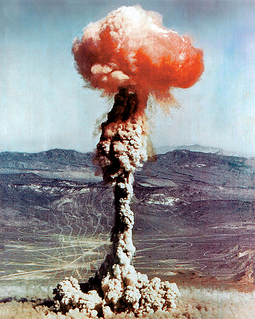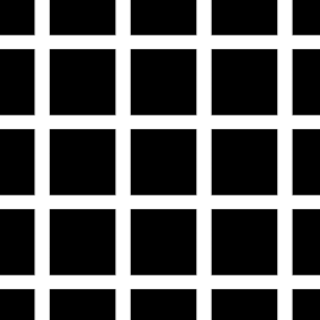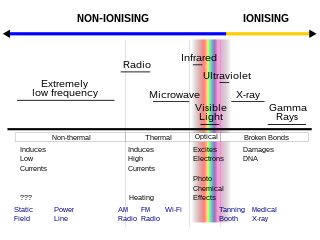The electromagnetic spectrum is the range of frequencies of electromagnetic radiation and their respective wavelengths and photon energies.

A Geiger counter is an instrument used for detecting and measuring ionizing radiation. Also known as a Geiger–Muller counter, it is widely used in applications such as radiation dosimetry, radiological protection, experimental physics, and the nuclear industry.

The ionosphere is the ionized part of Earth's upper atmosphere, from about 60 km (37 mi) to 1,000 km (620 mi) altitude, a region that includes the thermosphere and parts of the mesosphere and exosphere. The ionosphere is ionized by solar radiation. It plays an important role in atmospheric electricity and forms the inner edge of the magnetosphere. It has practical importance because, among other functions, it influences radio propagation to distant places on the Earth. The region below the ionosphere is called neutral atmosphere, or neutrosphere.

In physics, radiation is the emission or transmission of energy in the form of waves or particles through space or through a material medium. This includes:

A beta particle, also called beta ray or beta radiation, is a high-energy, high-speed electron or positron emitted by the radioactive decay of an atomic nucleus during the process of beta decay. There are two forms of beta decay, β− decay and β+ decay, which produce electrons and positrons respectively.
A radiation dosimeter is a device that measures dose uptake of external ionizing radiation. It is worn by the person being monitored when used as a personal dosimeter, and is a record of the radiation dose received. Modern electronic personal dosimeters can give a continuous readout of cumulative dose and current dose rate, and can warn the wearer with an audible alarm when a specified dose rate or a cumulative dose is exceeded. Other dosimeters, such as thermoluminescent or film types, require processing after use to reveal the cumulative dose received, and cannot give a current indication of dose while being worn.

Ionizing radiation is radiation, traveling as a particle or electromagnetic wave, that carries sufficient energy to detach electrons from atoms or molecules, thereby ionizing them. Ionizing radiation is made up of energetic subatomic particles, ions or atoms moving at high speeds, and electromagnetic waves on the high-energy end of the electromagnetic spectrum.

A scintillation counter is an instrument for detecting and measuring ionizing radiation by using the excitation effect of incident radiation on a scintillating material, and detecting the resultant light pulses.

The effects of a nuclear explosion on its immediate vicinity are typically much more destructive and multifaceted than those caused by conventional explosives. In most cases, the energy released from a nuclear weapon detonated within the lower atmosphere can be approximately divided into four basic categories:

A grid illusion is any kind of grid that deceives a person's vision. The two most common types of grid illusions are the Hermann grid illusion and the scintillating grid illusion.

A scintillator is a material that exhibits scintillation, the property of luminescence, when excited by ionizing radiation. Luminescent materials, when struck by an incoming particle, absorb its energy and scintillate. Sometimes, the excited state is metastable, so the relaxation back down from the excited state to lower states is delayed : the process then corresponds to either one of two phenomena, depending on the type of transition and hence the wavelength of the emitted optical photon: delayed fluorescence or phosphorescence.
In experimental and applied particle physics, nuclear physics, and nuclear engineering, a particle detector, also known as a radiation detector, is a device used to detect, track, and/or identify ionizing particles, such as those produced by nuclear decay, cosmic radiation, or reactions in a particle accelerator. Detectors can measure the particle energy and other attributes such as momentum, spin, charge, particle type, in addition to merely registering the presence of the particle.

Neutron detection is the effective detection of neutrons entering a well-positioned detector. There are two key aspects to effective neutron detection: hardware and software. Detection hardware refers to the kind of neutron detector used and to the electronics used in the detection setup. Further, the hardware setup also defines key experimental parameters, such as source-detector distance, solid angle and detector shielding. Detection software consists of analysis tools that perform tasks such as graphical analysis to measure the number and energies of neutrons striking the detector.
Cadmium tungstate (CdWO4 or CWO), the cadmium salt of tungstic acid, is a dense, chemically inert solid which is used as a scintillation crystal to detect gamma rays. It has density of 7.9 g/cm3 and melting point of 1325 °C. It is toxic if inhaled or swallowed. Its crystals are transparent, colorless, with slight yellow tint. It is odorless. Its CAS number is 7790-85-4. It is not hygroscopic.
Astroparticle physics, also called particle astrophysics, is a branch of particle physics that studies elementary particles of astronomical origin and their relation to astrophysics and cosmology. It is a relatively new field of research emerging at the intersection of particle physics, astronomy, astrophysics, detector physics, relativity, solid state physics, and cosmology. Partly motivated by the discovery of neutrino oscillation, the field has undergone rapid development, both theoretically and experimentally, since the early 2000s.
MARIACHI, the Mixed Apparatus for Radar Investigation of Cosmic-rays of High Ionization, is an apparatus for the detection of ultra-high-energy cosmic rays (UHECR) via bi-static radar interferometry using VHF transmitters. MARIACHI is also the name of the research project created and directed by Brookhaven National Laboratory (BNL) on Long Island, New York, initially intended to verify the concept that VHF signals can be reflected off the ionization patch produced by a cosmic ray shower. Project emphasis subsequently shifted to the attempted detection of radio wave reflections from a high energy ionization beam apparatus located at BNL's NASA Space Radiation Laboratory.

Polyvinyltoluene is a synthetic polymer of alkylbenzenes with a linear formula [CH2CH(C6H4CH3)]n. Commercial vinyl toluene is a mixture of methyl styrene isomers
Nuclear MASINT is one of the six major subdisciplines generally accepted to make up Measurement and Signature Intelligence (MASINT), which covers measurement and characterization of information derived from nuclear radiation and other physical phenomena associated with nuclear weapons, reactors, processes, materials, devices, and facilities. Nuclear monitoring can be done remotely or during onsite inspections of nuclear facilities. Data exploitation results in characterization of nuclear weapons, reactors, and materials. A number of systems detect and monitor the world for nuclear explosions, as well as nuclear materials production.
Sir Samuel Crowe Curran, FRS, FRSE DL LLD, was a physicist and the first Principal and Vice-Chancellor of the University of Strathclyde – the first of the new technical universities in Britain. He is the inventor of the scintillation counter, the proportional counter, and the proximity fuze. Colleagues generally referred to him simply as Sam Curran and latterly just as Sir Sam. To date, Curran remains the longest serving Principal and Vice Chancellor of the University of Strathclyde, holding the post for 16 years, not counting his previous 5 years as Principal of the Royal College of Science and Technology.

Non-ionizingradiation refers to any type of electromagnetic radiation that does not carry enough energy per quantum to ionize atoms or molecules—that is, to completely remove an electron from an atom or molecule. Instead of producing charged ions when passing through matter, non-ionizing electromagnetic radiation has sufficient energy only for excitation, the movement of an electron to a higher energy state. In contrast, ionizing radiation has a higher frequency and shorter wavelength than non-ionizing radiation, and can be a serious health hazard; exposure to it can cause burns, radiation sickness, cancer, and genetic damage. Using ionizing radiation requires elaborate radiological protection measures, which in general are not required with non-ionizing radiation.











